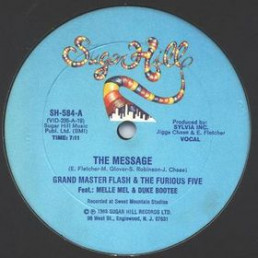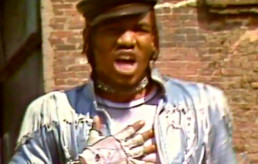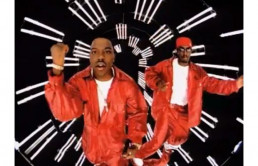‘The Message’ is the Medium
Greg de Cuir Jr
17’
Este programa oferece uma interseção entre música hip hop e vídeos musicais ou videoclips, desde os primeiros exemplares até ao período moderno do género, no final do século XX. Três músicas e respetivos vídeos são usados para mapear as mudanças na estética e na ideologia dos estilos sonoros e visuais do hip hop: ‘The Message’, de Grandmaster Flash & The Furious Five, ‘Check Yo Self’, de Ice Cube, e ‘Can’t Nobody Hold Me Down’, de Puff Daddy. A mais antiga das três obras, ‘The Message’ (1982), é um clássico do hip hop, que incorpora a crítica social na sua abordagem pioneira ao realismo da “rua”, numa composição musical que tem sido uma referência para múltiplos artistas de sucessivas gerações, que usam samples desta música, entre eles Ice Cube e Puff Daddy, incluídos neste programa. O videoclip de ‘The Message’, com a sua estética low-budget e realismo documental, pode ser considerado como um contributo raro e significativo para os primórdios da videoarte, do ponto de vista de uma classe urbana negra. Já os vídeos das músicas de Ice Cube e de Puff Daddy exemplificam a deslocação generalizada para as produções de vídeos musicais de larga escala e grandes orçamentos e, em paralelo, o amadurecimento do hip hop enquanto expressão artística, resultando na sua comercialização e na apropriação da sua ideologia pelo mainstream. Este programa online será complementado pela leitura, ao vivo, do texto “The Message is the Medium: Aesthetics, Ideology, and the Hip Hop Music Video” (publicado originalmente no volume “Music / Video: Histories, Aesthetics, Media” (2017), do escritor e curador Greg de Cuir Jr, seguida de uma discussão com o público sobre as questões abordadas no texto.
The Message _ Grandmaster Flash & The Furious Five, 6’, 1982
The Message é uma das músicas mais importantes do hip hop. É também conhecida pela sua letra, icónica e incisiva, da autoria de Melle Mel. O vídeo é um retrato documental cru do South Bronx, na cidade de Nova Iorque, o lendário berço do hip hop. Sylvia Robinson, fundadora e CEO da Sugar Hill Records, é creditada como escritora da letra, e é muito provável que tenha estado profundamente envolvida na produção do videoclip, o que a torna numa das primeiras videoartistas a precisar ser estudada.
The Message, Grandmaster Flash & The Furious Five, 1982, Sugar Hill Records
Compositores: Edward G. Fletcher, Melle Mel, Clifton ‘Jiggs’ Chase, Sylvia Robinson
Produtores: Edward G. Fletcher, Sylvia Robinson
BIO
Grandmaster Flash and the Furious Five foram um grupo americano de hip hop formado no sul do Bronx, Nova York, em 1978. Os membros do grupo eram Grandmaster Flash, Melle Mel, The Kidd Creole, Keef Cowboy, Ness/Scorpio e Rahiem. O uso de turntablism, breakbeat e lirismo consciente por parte do grupo foram significativos no desenvolvimento inicial da música hip hop. O grupo é amplamente considerado como um dos maiores grupos de todos os tempos.
Check Yo Self _ Ice Cube, 6’, 1993
Ice Cube ajudou a introduzir no hip hop o sub-género gangster rap. O vídeo para a música ‘Check Yo Self’ aparece como sequela do vídeo para o seu hit single ‘It Was a Good Day’, realizado por F. Gary Gray, que viria a conhecer a fama fazendo filmes em Hollywood. As referências cinemáticas são evidentes neste vídeo, no qual se realça a atuação e uma narrativa linear. Foi por esta altura que a MTV começou a incluir o nome do realizador nos vídeos que mostrava. Pode dizer-se que o vídeo musical atingiu, por essa altura, o estatuto de obra de arte.
Check Yo Self, Ice Cube, 1993, Priority Records
Compositor: Ice Cube
Produtores: DJ Muggs, Ice Cube
BIO
O’Shea Jackson Sr. (1969), mais conhecido pelo seu nome artístico Ice Cube, é um rapper, produtor musical, ator, escritor, comediante, produtor, e realizador norte-americano. Iniciou a sua carreira em 1984 como membro do grupo C.I.A. e depois entrou para o grupo de gangsta rap N.W.A em 1986. Depois de ter deixado os N.W.A em 1989, construiu uma carreira a solo bem sucedida na música, e também como escritor, realizador, ator e produtor de cinema.
Can’t Nobody Hold Me Down _ Puff Daddy, 5’, 1997
A comercialização do hip hop atingiu o cume com a fama de Puff Daddy. Este vídeo, feito para o seu primeiro single, foi realizado por Paul Hunter, um veterano dos vídeos musicais. O elevado orçamento está patente neste trabalho de índole cinematográfica, muito embora a sua estética tenha uma qualidade “high gloss”, identificada com um materialismo grosseiro, que encontra expressão nos cenários e adereços opulentos e na ostentação dos efeitos especiais. Este vídeo completa o percurso do hip hop no final do milénio; da rua para a estratosfera.
Can’t Nobody Hold Me Down, Puff Daddy, 1997, Bad Boy / Arista
Compositores: Sean ‘Puffy’ Combs, Steve Jordan, Carlos Broady, Nashiem Myrick, Mason Betha, Greg Prestopino, Matthew Wilder, Sylvia Robinson, Melvin Glover, Clifton ‘Jiggs’ Chase, Edward G. Fletcher
Produtores: Carlos Broady, Sean ‘Puffy’ Combs, Stevie J, Nashiem Myrick
BIO
Sean John Combs (1969), também conhecido pelos nomes artísticos Puff Daddy, Puffy, P. Diddy, Brother Love ou Diddy, é um rapper, cantor, compositor, produtor musical, executivo, empresário e ator. Combs nasceu em Nova York, mas foi criado em Mount Vernon. Ganhou três Grammy Awards e dois MTV Video Music Awards.
Greg de Cuir Jr é curador independente, escritor e tradutor. Vive e a trabalha em Belgrado, Sérvia. Recentemente, fez programação para instituições como: Eye Filmmuseum, em Amsterdão; Arsenal, em Berlin; Anthology Film Archives em Nova-Iorque, e para a School of the Art Institute of Chicago. Viu a sua escrita ser publicada em revistas como CURA. e Non-Fiction. Deu, recentemente, palestras na Universidade de Chicago e no Sandberg Instituut | Rietveld Academie, em Amsterdão.
“FUSO 2020 – August 27th to 30th
August 30th
‘The Message’ is the Medium
Greg de Cuir Jr
17’
This program offers a cross-section of hiphop music and music videos from the early to modern period of the genre in the twentieth century. Three songs and their accompanying videos are utilised to chart the shifts in aesthetics and ideology in hiphop audio and visual style: ‘The Message’ by Grandmaster Flash & The Furious Five, ‘Check Yo Self’ by Ice Cube and ‘Can’t Nobody Hold Me Down’ by Puff Daddy. The earliest of these pieces, ‘The Message’ (1982), serves as classical urtext for hiphop with both its pioneering method of street-level realism and social critique and an iconic musical composition that has been sampled and referenced by multiple artists of successive generations, among them the examples of Ice Cube and Puff Daddy i this program. The music video for ‘The Message’ can be considered a significant and rare contribution to early video art from the perspective of the black urban class, with its low-budget aesthetic and documentary realism. The videos for the songs by Ice Cube and Puff Daddy exemplify the large-scale, big budget cinematic shift in music video production in general and also the maturation of hiphop as an art, along with the resulting commercialisation of the form and the mainstreaming of its ideology. This online program will be complemented by a live reading of the text ‘The Message is the Medium: Aesthetics, Ideology, and the Hip Hop Music Video’ (originally published in the volume Music / Video: Histories, Aesthetics, Media [2017]) by writer-curator Greg de Cuir Jr, followed by a discussion on the points raised.
The Message _ Grandmaster Flash & The Furious Five, 6’, 1982
One of the most important hiphop songs ever written. It is known primarily for the incisive and iconic lyrics by Melle Mel. The video is characterised by a raw documentary portrait of the South Bronx in New York City, the legendary birthplace of hiphop. Sylvia Robinson, Founder/CEO of Sugar Hill Records, was credited as a songwriter, and it is likely that she was also closely involved in the production of the music video, which makes her an early video artist in need of study.
The Message, Grandmaster Flash & The Furious Five, 1982, Sugar Hill Records
Writers: Edward G. Fletcher, Melle Mel, Clifton ‘Jiggs’ Chase, Sylvia Robinson
Producers: Edward G. Fletcher, Sylvia Robinson
BIO
Grandmaster Flash and the Furious Five was an American hip hop group formed in the South Bronx of New York City in 1978. The group’s members were Grandmaster Flash, Melle Mel, The Kidd Creole, Keef Cowboy, Mr. Ness/Scorpio and Rahiem. The group’s use of turntablism, breakbeat DJing, and conscious lyricism were significant in the early development of hip hop music. The group is widely regarded as one of the greatest groups of all time.
Check Yo Self _ Ice Cube, 6’, 1993
Ice Cube helped introduce the subgenre of gangster rap. The video for his song ‘Check Yo Self’ is depicted as a sequel to the video for his hit single ‘It Was a Good Day’, directed by F. Gary Gray, who would go on to fame making Hollywood movies. A cinematic mode is utilised here, in which acting and linear storytelling is prioritised. Around this time MTV began including credits that detailed the name of the director. One might say that the music video then achieved the status of a work of art.
Check Yo Self, Ice Cube, 1993, Priority Records
Writer: Ice Cube
Producers: DJ Muggs, Ice Cube
BIO
O’Shea Jackson Sr. (1969), better known by his stage name Ice Cube, is an American rapper, music producer, actor, writer, comedian, producer, and director. He started his career in 1984 as a member of the C.I.A. and then joined the gangsta rap group N.W.A in 1986. After leaving N.W.A in 1989, he built a successful solo career in music, as well as as a writer, director, actor and film producer.
Can’t Nobody Hold Me Down _ Puff Daddy, 5’, 1997
The commercialisation of hiphop reached an apex with the rise of Puff Daddy. This video for his first single was directed by Paul Hunter, a veteran of music videos. The high budget cinematic mode is evident in this work, but we might call this a ‘high gloss’ aesthetic, in which crass materialism is given visual correlatives with opulent sets and props, and ostentatious special effects. This video completes the arc of late twentieth century hiphop, from the streets and into the stratosphere.
Can’t Nobody Hold Me Down, Puff Daddy, 1997, Bad Boy / Arista
Writers: Sean ‘Puffy’ Combs, Steve Jordan, Carlos Broady, Nashiem Myrick, Mason Betha, Greg Prestopino, Matthew Wilder, Sylvia Robinson, Melvin Glover, Clifton ‘Jiggs’ Chase, Edward G. Fletcher
Producers: Carlos Broady, Sean ‘Puffy’ Combs, Stevie J, Nashiem Myrick
BIO
Sean John Combs (1969) also known by the stage names Puff Daddy, Puffy, P. Diddy, Brother Love or Diddy, is an American rapper, singer, songwriter, record producer, record executive, entrepreneur, and actor. Combs was born in New York City but was raised in Mount Vernon, New York. He has won three Grammy Awards and two MTV Video Music Awards.
Greg de Cuir Jr is an independent curator, writer, and translator who lives and works in Belgrade (Serbia). He most recently organised programs for Eye Filmmuseum in Amsterdam, Arsenal in Berlin, Anthology Film Archives in New York, and School of the Art Institute of Chicago, among other institutions. His writing was most recently published in the magazines CURA. and Non-Fiction. He most recently delivered talks at University of Chicago and Sandberg Instituut | Rietveld Academie in Amsterdam.









